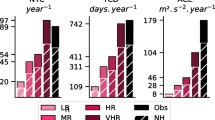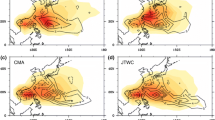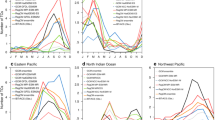Abstract
Fine-resolution (18 km) regional climate model simulations using the GFDL regional climate model ZETAC are implemented over a South Pacific domain, where the interannual variability of tropical cyclone formation is large. When forced with observed sea surface temperatures and reanalysis boundary conditions, the model is able to give a good simulation of the interannual variation of regions of tropical cyclone formation, with tropical cyclones simulated to form much further east during El Niño years, as observed. An imposed climate-change perturbation is applied to the model, with the resulting simulation indicating that fewer tropical cyclones form in this region in a warmer world. This result appears to be most closely related to increased vertical velocity in the equatorial Pacific, leading to compensating subsidence in the adjacent tropical cyclone formation regions of the South Pacific, thus suppressing tropical cyclone formation.













Similar content being viewed by others
References
Adler RF, Huffman GJ, Chang A, Ferraro R, Xie P, Janowiak J, Rudolf B, Schneider U, Curtis S, Bolvin D, Gruber A, Susskind J, Arkin P (2003) The version 2 Global Precipitation Climatology Project (GPCP) monthly precipitation analysis (1979–present). J Hydrometeorol 4:1147–1167
Basher RE, Zheng X (1995) Tropical cyclones in the southwest Pacific: spatial patterns and relationships to Southern Oscillation and sea surface temperature. J Clim 8:1249–1260
Bender MA, Knutson TR, Tuleya RE, Sirutis JJ, Vecchi GA, Garner ST, Held IM (2010) Modeled impact of anthropogenic warming on the frequency of intense Atlantic hurricanes. Science 327:454–458
Camargo SJ, Emanuel KA, Sobel AH (2007) Use of a genesis potential index to diagnose ENSO effects on tropical cyclone genesis. J Clim 20:4819–4834
Chand SS, Walsh KJE (2009) Tropical cyclone activity in the Fiji region: spatial patterns and relationship to large-scale circulation. J Clim 22:3877–3893
Christensen JH, Krishna Kumar K, Aldrian E, An S-I, Cavalcanti IFA, de Castro M, Dong W, Goswami P, Hall A, Kanyanga JK, Kitoh A, Kossin J, Lau N-C, Renwick J, Stephenson DB, Xie S-P, Zhou T (2013) Climate phenomena and their relevance for future regional climate change. In: Stocker TF, Qin D, Plattner G-K, Tignor M, Allen SK, Boschung J, Nauels A, Xia Y, Bex V, Midgley PM (eds) Climate change 2013: the physical science basis. Contribution of Working Group I to the Fifth Assessment Report of the Intergovernmental Panel on Climate Change. Cambridge University Press, Cambridge, pp 1217–1308
DelSole T, Shukla J (2010) Model fidelity versus skill in seasonal forecasting. J Clim 23:4794–4806
Emanuel KA (2013) Downscaling CMIP5 climate models shows increased tropical cyclone activity over the 21st century. Proc Natl Acad Sci. doi:10.1073/pnas.1301293110
Held IM, Zhao M (2011) The response of tropical cyclone statistics to an increase in CO2 with fixed sea surface temperatures. J Clim 24:5353–5364
Jourdain N, Marchesiello P, Menkes CE, Lefèvre J, Vincent EM, Lengaigne M, Chauvin F (2011) Mesoscale simulation of tropical cyclones in the South Pacific: climatology and interannual variability. J Clim 24:3–25
Kanamitsu M, Ebisuzaki W, Woollen J, Yang S-K, Hinlo JJ, Fiorino M, Potter GL (2002) NCEP-DOE AMIP-II reanalysis (R-2). Bull Am Meteorol Soc 83:1631–1643
Knapp K, Kruk M, Levinson D, Diamond H, Neumann C (2010) The international best track archive for climate stewardship (IBTrACS): unifying tropical cyclone best track data. Bull Am Meteorol Soc 91:363–376
Knutson TR, Sirutis JJ, Garner ST, Held IM, Tuleya RE (2007) Simulation of the recent multidecadal increase of Atlantic hurricane activity using an 18-km-grid regional model. Bull Am Meteorol Soc 88:1549–1565
Knutson TR, Sirutis JJ, Garner ST, Vecchi GA, Held I (2008) Simulated reduction in Atlantic hurricane frequency under twenty-first-century warming conditions. Nat Geosci 1:359–364
Knutson TR, McBride JL, Chan J, Emanuel K, Holland G, Landsea C, Held I, Kossin JP, Srivastava AK, Sugi M (2010) Tropical cyclones and climate change. Nat Geosci 3:157–163
Lavender SL, Walsh KJE (2011) Dynamically downscaled simulations of Australian region tropical cyclones in current and future climates. Geophys Res Lett. doi:10.1029/2011GL047499
Lin Y-L, Farley RD, Orville HD (1983) Bulk parameterization of the snow field in a cloud model. J Clim Appl Meteorol 22:1065–1092
Lord SJ, Willoughby HE, Piotrowicz JM (1984) Role of a parametrised icephase microphysics in an axisymmetric nonhydrostatic tropical cyclone model. J Atmos Sci 41:2836–2848
Menkes CE, Lengaigne M, Marchesiello P, Jourdain NC, Vincent EM, Lefevre J, Chauvin F, Royer J-F (2012) Comparison of tropical cyclonegenesis indices on seasonal to interannual timescales. Clim Dyn 38:301–321
Murakami H, Mizuta R, Shindo E (2012) Future changes in tropical cyclone activity projected by multi-physics and multi-SST ensemble experiments using the 60-km-mesh MRI-AGCM. Clim Dyn 39:2569–2584
Oouchi K, Yoshimura J, Yoshimura H, Mizuta R, Kusunoki S, Noda A (2006) Tropical cyclone climatology in a global-warming climate as simulated in a 20 km mesh global atmospheric model: frequency and wind intensity. J Meteorol Soc Jpn 84:259–276
Pauluis O, Garner ST (2006) Sensitivity of radiative–convective equilibrium simulations to horizontal resolution. J Atmos Sci 63:1910–1923
Rappin ED, Nolan DS, Emanuel KA (2010) Thermodynamic control of tropical cyclogenesis in environments of radiative–convective equilibrium with shear. Q J R Meteorol Soc 136:1954–1971
Sarachik ES, Cane MA (2010) The El Niño-southern oscillation phenomenon. Cambridge University Press, New York
Shapiro LJ (1987) Month-to-month variability of Atlantic tropical circulation and its relationship to tropical cyclone formation. Mon Weather Rev 115:2598–2614
Sugi M, Noda A, Sato N (2002) Influence of the global warming on tropical cyclone climatology: an experiment with the JMA global model. J Meteorol Soc Jpn 80:249–272
Sugi M, Murakami H, Yoshimura J (2012) On the mechanism of tropical cyclone frequency changes due to global warming. J Meteorol Soc Jpn 90A:397–408
Vecchi G, Soden B (2007) Effect of remote sea surface temperature change on tropical cyclone potential intensity. Nature 450:1066–1071
Vincent DG (1994) The South Pacific convergence zone (SPCZ): a review. Mon Weather Rev 122:1949–1970
Vitart F, Anderson JL, Stern WF (1997) Simulation of interannual variability of tropical storm frequency in an ensemble of GCM integrations. J Clim 10:745–760
Vitart F, Anderson D, Stockdale T (2003) Seasonal forecasting of tropical cyclone landfall over Mozambique. J Clim 16:3932–3945
Von Storch H, Zwiers F (1999) Statistical analysis in climate research. Cambridge University Press, Cambridge
Walsh KJE, Nguyen K-C, McGregor JL (2004) Fine-resolution regional climate model simulations of the impact of climate change on tropical cyclones near Australia. Clim Dyn 22:47–56
Walsh K, Fiorino M, Landsea C, McInnes K (2007) Objectively-determined resolution-dependent threshold criteria for the detection of tropical cyclones in climate models and reanalyses. J Clim 20:2307–2314
Walsh KJE, McInnes KL, McBride JL (2012) Climate change impacts on tropical cyclones and extreme sea levels in the South Pacific—a regional assessment. Glob Plan Change 80–81:149–164
Walsh KJE, Camargo SJ, Vecchi GA, Daloz AS, Elsner J, Emanuel K, Horn M, Lim Y-K, Roberts M, Patricola C, Scoccimarro E, Sobel AH, Strazzo S, Villarini G, Wehner M, Zhao M, Kossin J, LaRow T, Oouchi K, Schubert S, Wang H, Bacmeister J, Chang P, Chauvin F, Jablonowski C, Murakami H, Ose T, Reed KA, Saravanan R, Yamada Y, Zarzycki CM, Vidale P-L, Jonas JA, Henderson N (2015) Hurricanes and climate: the U.S. CLIVAR working group on hurricanes. Bull Am Meteorol Soc (to appear)
Wu L, Chou C, Chen C-T, Huang R, Knutson TR, Sirutis JJ, Garner ST, Kerr C, Lee C-J, Feng Y-C (2014) Simulations of the present and late 21st century western North Pacific tropical cyclone activity using a regional model. J Clim 27:3405–3424
Xie P, Arkin PA (1997) Global precipitation: a 17-year monthly analysis based on gauge observations, satellite estimates, and numerical model outputs. Bull Am Meteorol Soc 78:2539–2558
Yoshimura J, Sugi M (2005) Tropical cyclone climatology in a high-resolution AGCM—impacts of SST warming and CO2 increase. SOLA 1:133–136
Zhao M, Held IM, Lin S-J, Vecchi GA (2009) Simulations of global hurricane climatology, interannual variability, and response to global warming using a 50-km resolution GCM. J Clim 22:6653–6678
Zhao M, Held IM, Vecchi G, Scoccimarro E, Wang H, Wehner M, Lim Y-K, LaRow T, Camargo SJ, Walsh K, Gualdi S, Kumar A, Schubert S (2013) Robust direct effect of increasing atmospheric CO2 concentration on global tropical cyclone frequency—a multi-model inter-comparison. CLIVAR Var, Fall
Acknowledgments
The authors would like to acknowledge the Pacific-Australia Climate Change Science and Adaptation Program of the Australian Department of Climate Change and Energy Efficiency for providing partial funding for this research, particularly Jack Katzfey of CSIRO, who managed this project. The first author would like to thank the Princeton University/GFDL Visiting Scientist Program for providing the opportunity to visit GFDL, where this work was commenced. The author would also like to thank Tom Knutson, Steve Garner, Chris Kerr and Joe Sirutis of GFDL for assistance and helpful discussions regarding this work. The simulations were performed on the Australian NCI national supercomputing facility.
Author information
Authors and Affiliations
Corresponding author
Rights and permissions
About this article
Cite this article
Walsh, K. Fine resolution simulations of the effect of climate change on tropical cyclones in the South Pacific. Clim Dyn 45, 2619–2631 (2015). https://doi.org/10.1007/s00382-015-2497-1
Received:
Accepted:
Published:
Issue Date:
DOI: https://doi.org/10.1007/s00382-015-2497-1




